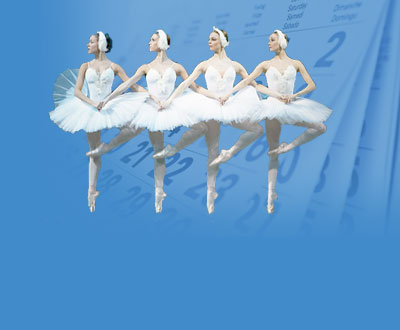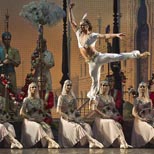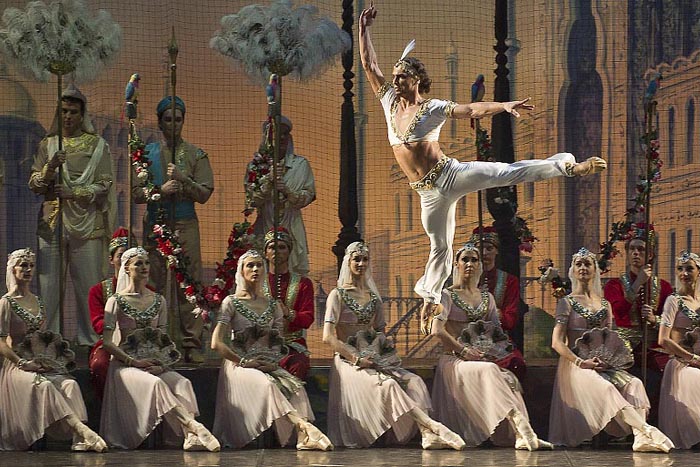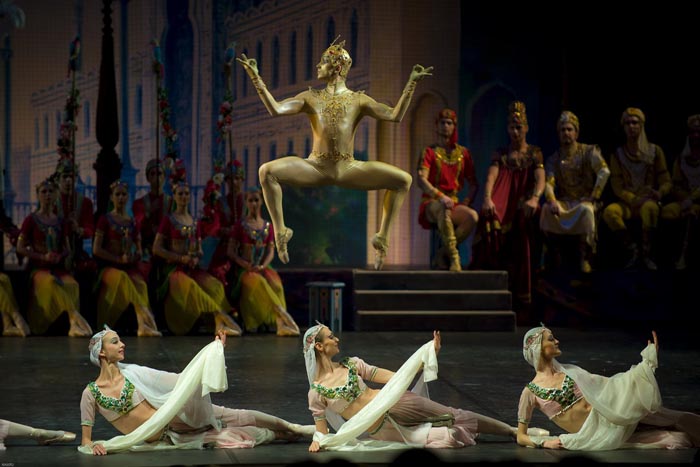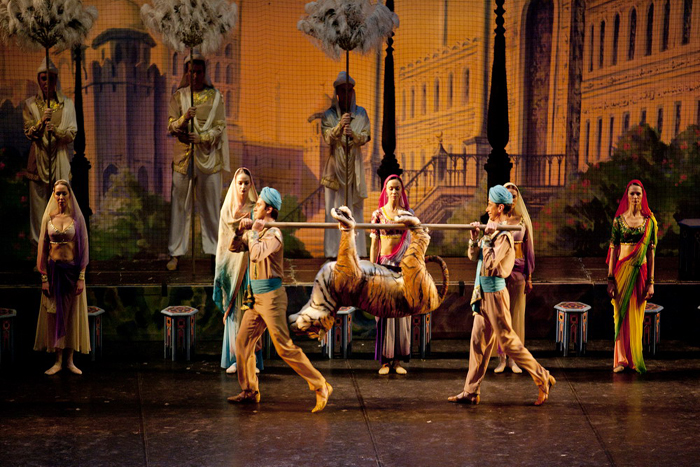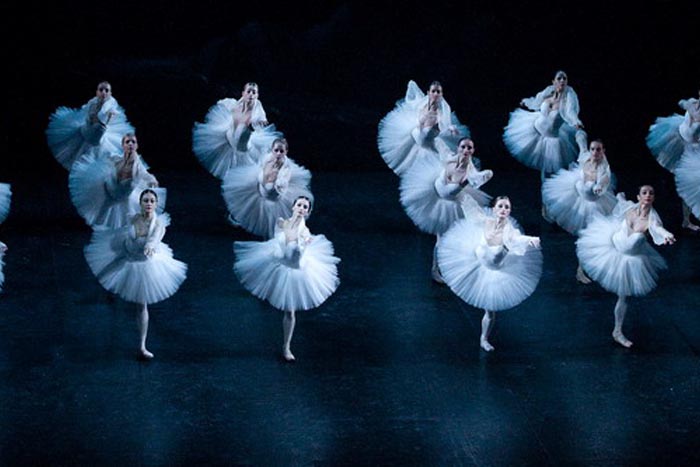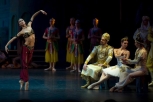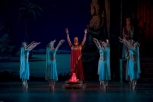Schedule of all St. Petersburg theaters on
one page >>
Please enter theatre's name, actor's name or any other keyword
La Bayadère (Mikhailovsky Theatre, ballet) - 17 February 2026 at 19:00
Mikhailovsky (ex. Mussorgsky) Theatre More info | Price: 134.76 - 306.28 USD
Genre: Ballet Age restriction: 12+ Length: 3 hours Intermissions: 2 Opening night: 15 February 2012
Credits
Libretto: Marius Petipa, Sergey Khudekov
Choreography by Marius Petipa
revised by Vladimir Ponomaryov and Vakhtang Chabukiani
The Bronze Idol Dance choreographed by Nikolay Zubkovsky
Overall choreographic revision: Mikhail Messerer
Assistants: Evgeny Popov, Anna Razenko
Stage Designer: Vyacheslav Okunev
Head of Production Costume: Alla Marusina Lighting Designer: Alexander Kibitkin
Repetiteurs: Nikita Dolgushin, Alla Osipenko, Evgenia Kostyleva, Tatiana Legat, Svetlana Efremova, Yury Gumba, Natalia Tsyplakova
Sets and costumes produced at Vozrozhdenie Theatrical Design Studios
Premiere of the production at the Mikhailovsky Theatre: 21 October 2000
Premiere of the new revision: 15 February 2012
La Bayadère is just one of several lavish ballets created by Marius Petipa which take place in ‘exotic’ settings. Marius Petipa, the famed choreographer of St Petersburg, created La Bayadèrein 1877, basing it on a play by an Indian poet.A bayadère is a female temple dancer. Such figures were popular in 19th-century ballets when character dancing was often contrasted with pure classical dance. This is the only surviving such ballet set wholly in the exotic East.
It is a true Romantic ballet in structure, as its two acts are full of local colour and domestic wranglings, while the third act takes place in an all-white other world inhabited by ghostly beings. One of the most impressing scenes of the third act is the one called The Kingdom of the Shades. According to the choreographer’s own memoirs, the mesmerizing choreographic solution used for the entrance of the original 48 ’Shades’, had been prompted by an engraving by the Romantic artist Gustav Doré.
Act I
Scene one
The holy woods in front of the pagoda. Young noble warriors return from tiger hunting. The rich Kshatriya Solor, the renowned warrior, appears with a bow in his hand. He orders the warriors to leave him on his own at the holy fire. Solor asks the fakir Magedaveya to find an opportunity to talk to the beautiful Nikiya, the bayadère, who lives in the temple, and tell her that he’ll be waiting for her at the pagoda at night. Solor leaves.
The ceremonial arrival of the High Brahman, priests and bayadères, the temple dancers, heralds the beginning of the feast of worshipping the fire. The climax of the feast is Nikiya’s dance.
The passion to Nikiya makes the High Brahman forget his vocation and celibacy associated with it. He promises her all the riches of India, whatever she wants. But Nikiya can’t hide her disgust for the High Brahman.
In the night. The secret meeting of Nikiya and Solor is safeguarded by Magedaveya. Solor swears his eternal love and fidelity to Nikiya by the holy fire.
They’re seen by the High Brahman, who is eager to revenge.
Scene two
At the Rajah Dugmanta’s palace. The Rajah orders to call the bayadères so that they would entertain him and his guests. Dugmanta announces to his daughter Gamzatti that she’ll marry the best and bravest warrior of the rajaship, Solor, who she’s been engaged to since her childhood. Gamzatti is happy, and Solor is lost: he doesn’t dare reject the high honor, but he loves Nikiya and has sworn fidelity to her.
The High Brahman arrives. Hoping to destroy the rival, he tells the Rajah about Nikiya and Solor’s love. Dugmanta is enraged, but he wouldn’t change his decision. Solor will marry his daughter and the bayadère is to die. The Brahman hasn’t expected such a catastrophe, he threatens the Rajah with the revenge of the gods for the bayadère’s death, but Dugmanta is adamant.
Gamzatti has overheard the conversation and orders her slave to bring Nikiya to her. The slave returns announcing Nikiya’s arrival. The bayadère is bowing down, as she’s approaching the Rajah’s daughter. Gamzatti looks at her and finds her beautiful. She tells Nikiya about her soon wedding and invites the bayadère to dance on that day. Nikiya is flattered by the honour, but suddenly Gamzatti, as if by chance, shows her the portrait of her husband-to-be. Nikiya is desperate, she is protesting. Solor loves only her and he’ll only hers. Gamzatti begs Nikiya to give Solor up but the bayadère would rather die than part with her beloved. Gamzatti offers Nikiya jewelry in exchange to Solor. Enraged Nikiya chops a dagger at her — and by chance the slave come in time and manages to stop the bayadère. The Rajah’s daughter swears: Nikiya will die.
Act II
Scene three
Square in front of the Rajah’s palace. Gamzatti and Solor’s engagement.
Nikiya, who is obliged to dance at the feast according to the ritual, can’t conceal her grief. But suddenly she is presented with a flower basket. She’s full of hope, love and happiness — she’s triumphant: it’s surely Solor’s gift.
Suddenly a snake crawls out of the flowers and stings the bayadère. This is Gamzatti’s revenge.
The High Brahman promises her an antidote if Nikiya forgets Solor, however, she’s faithful to her beloved. When dying, Nikiya reminds Solor of his vow.
Act III
Scene four
Solor’s inconsolable. She’s full of remorse. He drops into sleep and sees the Kingdom of Shades. They descend from mountain ledges in a long line. He sees Nikiya. She’s calling him...


 en
en es
es